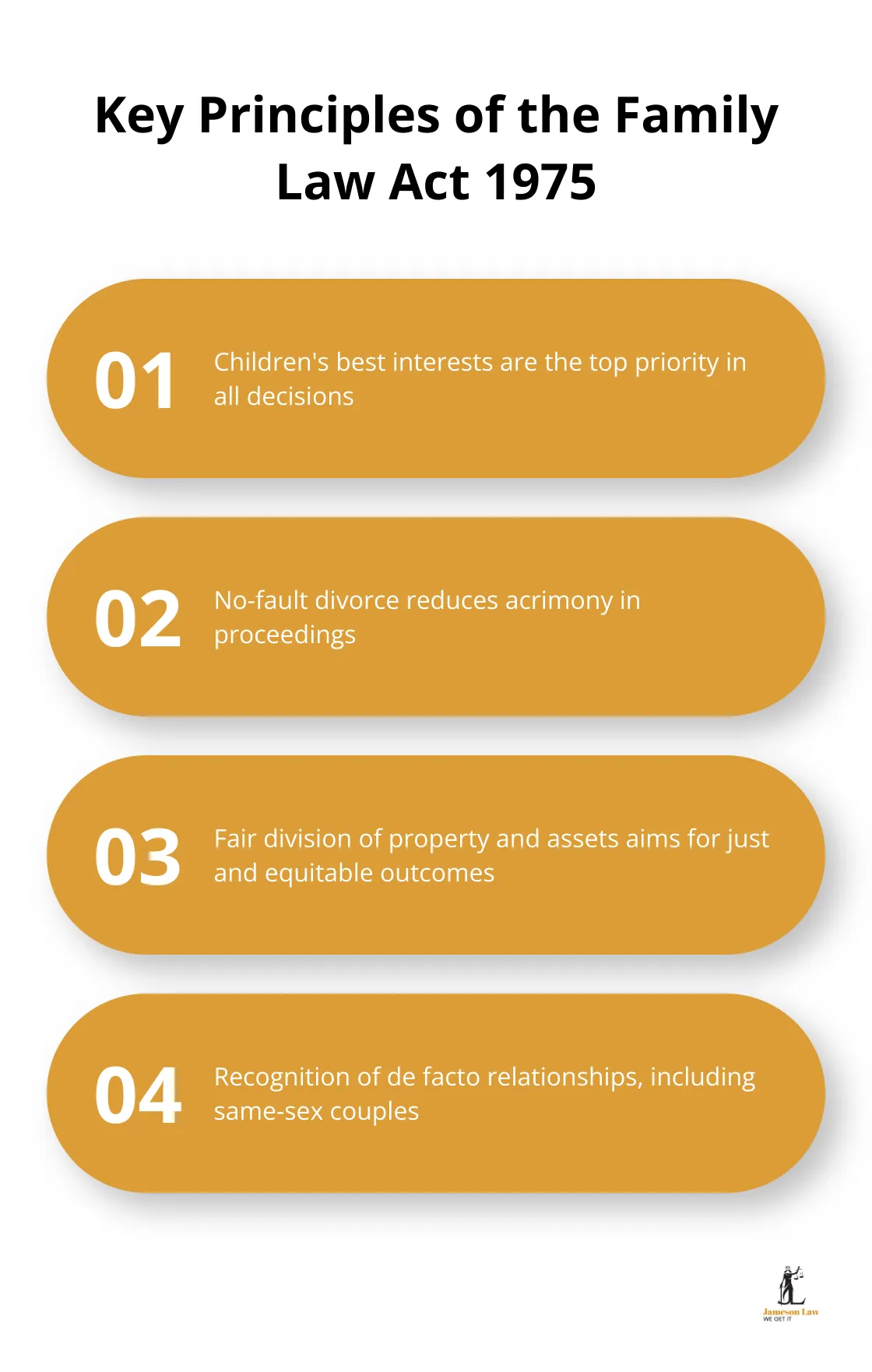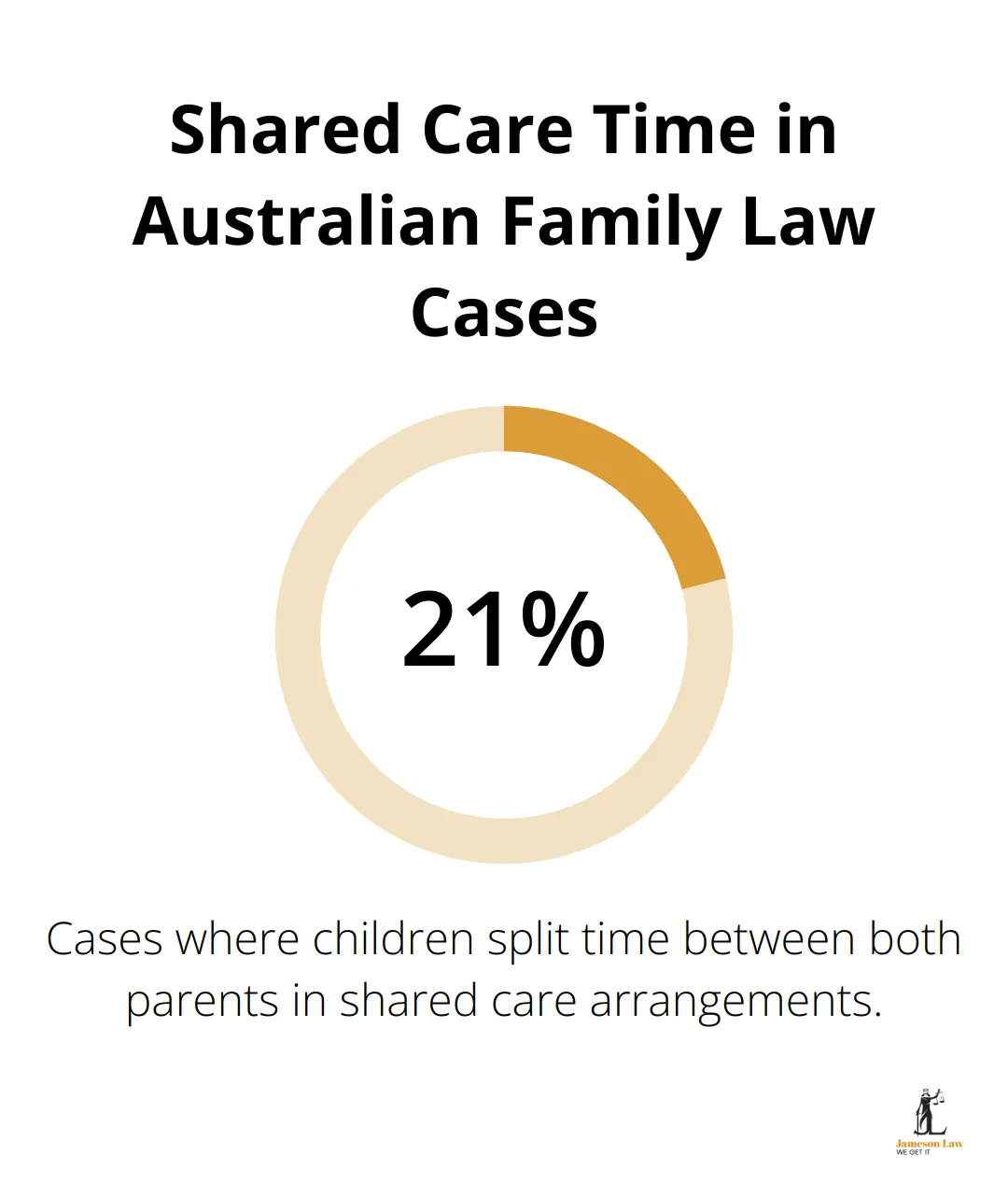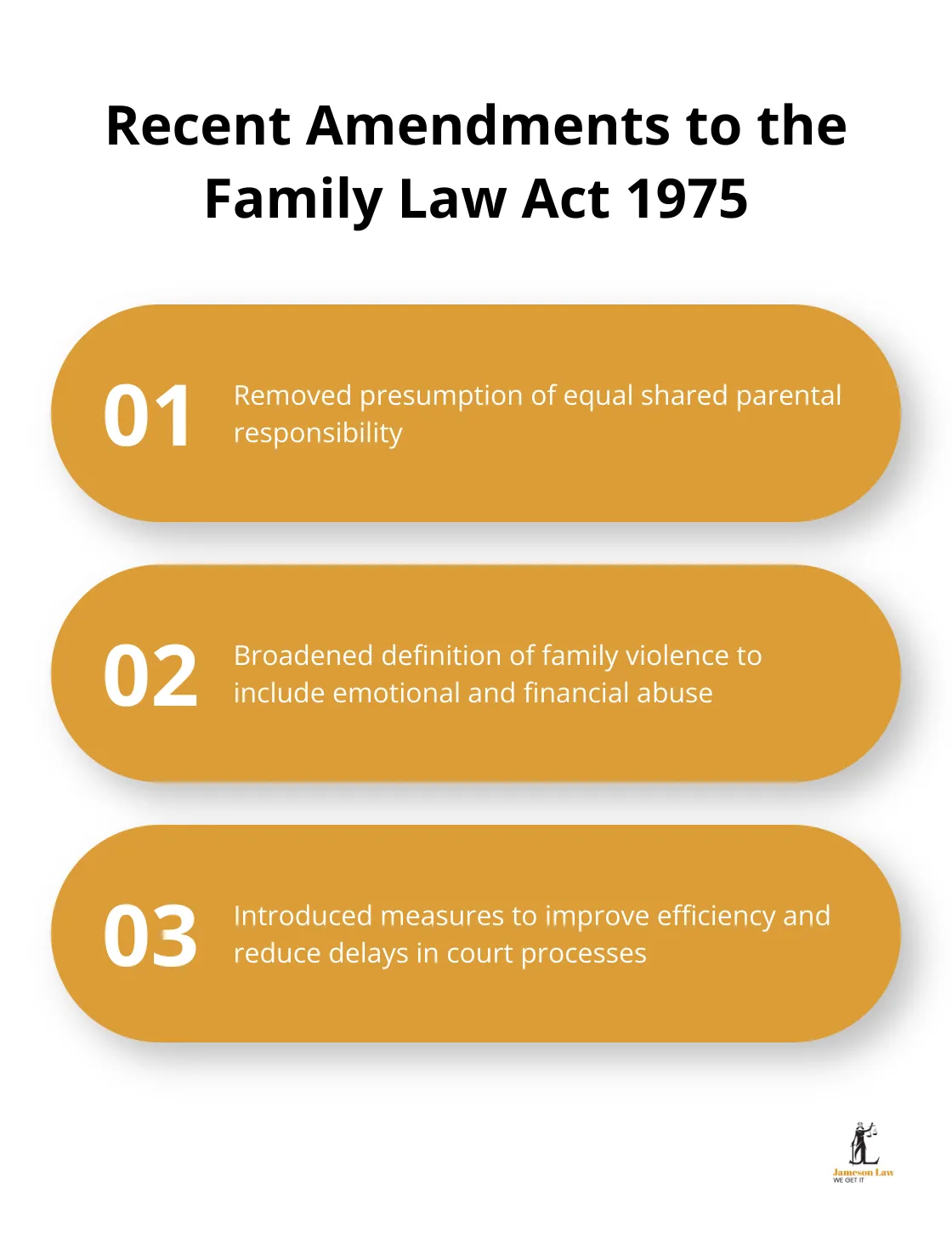The Family Law Act 1975 is a cornerstone of Australian family law, shaping how we handle divorce, child custody, and property division.
At Jameson Law, we understand the complexities of this legislation and its impact on families across the country.
This blog post will break down the essential points of the Family Law Act 1975, including its key principles, important sections, and recent amendments.
Key Principles of the Family Law Act 1975
The Family Law Act 1975 forms the foundation of Australian family law, guiding how we handle divorce, child custody, and property division. This chapter will explore the fundamental principles that shape family law matters in Australia.
Children’s Best Interests: The Top Priority
The Act places children’s welfare at the forefront of all decisions. In any dispute involving children, their needs and well-being take precedence over the wishes of parents or other parties. Courts consider factors such as:
- The child’s relationship with each parent
- Their safety
- Their emotional and developmental needs
This principle often results in shared parenting arrangements, where both parents remain actively involved in their children’s lives post-separation. However, equal time with both parents isn’t always deemed to be in a child’s best interests (especially in cases involving family violence or abuse).
No-Fault Divorce: A Game-Changer
The introduction of no-fault divorce revolutionized the Family Law Act 1975. Couples seeking a divorce don’t need to prove wrongdoing by either party. They only need to demonstrate that their marriage has irretrievably broken down, typically evidenced by 12 months of separation.
This approach reduces the acrimony often associated with divorce proceedings. It allows couples to focus on practical matters like property division and child custody arrangements, rather than assigning blame. However, while fault isn’t considered for the divorce itself, it may still be relevant in other aspects of family law (such as property settlements in cases of financial misconduct).

Fair Division of Property and Assets
The Act aims for a just and equitable division of property and assets between separating couples. This doesn’t necessarily mean a 50-50 split in every case. The court considers various factors, including:
- Each party’s financial contributions to the relationship
- Non-financial contributions (e.g., caring for children or maintaining the home)
- Future needs of each party
For example, a stay-at-home parent who sacrificed career opportunities to care for children might receive a larger share of assets to account for their reduced earning capacity. Similarly, a party with ongoing medical needs or limited employment prospects might be awarded additional assets to ensure their future financial security.
Recognition of De Facto Relationships
The Family Law Act 1975 has evolved to recognize de facto relationships, granting them similar rights and protections as married couples in many areas of family law. This includes same-sex relationships, which have been fully recognized under the Act since 2009.
De facto relationships under Family Law Act 1975 are now subject to court orders regarding the division of property, similar to marriages. De facto partners can access the family law courts for property settlements and spousal maintenance, provided they meet certain criteria. These typically include:
- Living together on a genuine domestic basis for at least two years
- Having a child together
This recognition has significant practical implications. De facto partners separating after a long-term relationship can now seek a fair division of assets, even if those assets are only in one partner’s name. It also means that de facto partners can be held responsible for child support in the same way as married couples.
Understanding these key principles is essential for anyone navigating the family law system in Australia. They shape outcomes in everything from simple divorces to complex custody battles. While these principles provide a framework, it’s important to note that every family law case is unique, and outcomes can vary significantly based on individual circumstances. In the next chapter, we’ll examine important sections of the Family Law Act 1975 that put these principles into practice.
Key Sections of the Family Law Act 1975
Children’s Rights and Parental Responsibilities
Section 60B of the Act outlines the rights of children and the responsibilities of parents. This section emphasizes that children have the right to know and be cared for by both parents, regardless of whether their parents are married, separated, or have never lived together.
Shared care time, where children split their time between both parents, occurs in 21% of cases. This statistic underscores the importance of Section 60B in promoting ongoing relationships between children and both parents.
However, this section also recognizes that children need protection from physical or psychological harm. In cases where there are concerns about a child’s safety, the court may limit or supervise contact with a parent. According to the Australian Bureau of Statistics, in 2021, approximately 2.5% of children in Australia were subject to child protection investigations or interventions.

Property Settlements
Section 79 of the Act deals with property settlements between separating couples. This section gives courts the power to alter property interests in a way that is just and equitable.
The process of property settlement under Section 79 typically involves four steps:
- Identification and valuation of all assets and liabilities
- Assessment of the contributions of each party (both financial and non-financial)
- Consideration of future needs of each party
- Ensuring the overall settlement is just and equitable
Recent data from the Australian Institute of Family Studies shows that in 2022, the average property settlement split was 55% to the wife and 45% to the husband. However, this can vary significantly based on individual circumstances.
Financial Agreements
Sections 90B to 90KA of the Act cover financial agreements (commonly known as prenuptial or postnuptial agreements). These agreements allow couples to decide how their property and financial resources will be divided if their relationship breaks down.
Financial agreements can be made before, during, or after a marriage or de facto relationship. They can cover issues such as:
- Division of property and financial resources
- Spousal maintenance
- Other financial matters
It’s important to note that for a financial agreement to be binding, both parties must receive independent legal advice before signing. The trend of declining marriage rates in Australia corresponds with a meteoric rise in couples who live together outside of marriage.
The trend of couples seeking financial agreements has grown, particularly among those entering second marriages or with significant assets. Legal advice is recommended before entering into these agreements to ensure they’re fair and legally binding.
Restrictions on Publication of Court Proceedings
Section 121 of the Family Law Act 1975 imposes strict restrictions on the publication of court proceedings. This section aims to protect the privacy of individuals involved in family law matters, especially children.
The section prohibits the publication of any account of proceedings (or part of proceedings) that identifies:
- A party to the proceedings
- A person who is related to, or associated with, a party to the proceedings
- A witness in the proceedings
Violations of this section can result in severe penalties, including imprisonment. This provision underscores the sensitive nature of family law matters and the importance of maintaining confidentiality.
These key sections of the Family Law Act 1975 form the backbone of family law practice in Australia. They provide a framework for resolving disputes and protecting the rights of all parties involved. As we move forward, we’ll examine recent amendments to the Act that have further shaped its application in modern Australian society.
How Recent Amendments Have Changed Family Law
Shared Parental Responsibility
The 2006 amendments to the Family Law Act 1975 introduced a presumption of equal shared parental responsibility. However, recent changes have removed this presumption. This change emphasizes the importance of both parents in a child’s life. The Australian Institute of Family Studies reported a 3% increase in shared care arrangements between 2006 and 2012.
The presumption doesn’t apply in cases of family violence or child abuse. The amendments also require parents to attempt family dispute resolution before court proceedings. This requirement resulted in a 25% decrease in court filings for parenting matters between 2006 and 2010.
Addressing Family Violence
The 2011 amendments broadened the definition of family violence to include emotional and financial abuse. These changes also introduced new requirements for filing notices and supporting affidavits in family law cases.
These changes removed the ‘friendly parent’ provision, which had discouraged victims from reporting abuse (for fear of being seen as uncooperative). More parents now speak up about safety concerns without fear of repercussions in custody decisions.

Streamlining Court Processes
The 2018 amendments aimed to improve efficiency in the family law system. They introduced measures to reduce delays and simplify procedures. These changes were designed to address the often lengthy process from application to final orders in Family Courts.
These changes also expanded the powers of the Federal Circuit Court, allowing it to hear a wider range of family law matters. This expansion has improved access to justice for many Australians (particularly in regional areas where Family Court sittings are less frequent).
Impact on Legal Practice
The amendments have significantly altered how lawyers approach family law cases. Practitioners now place greater emphasis on alternative dispute resolution methods. They also conduct more thorough risk assessments in cases involving allegations of family violence.
These changes require lawyers to stay updated with the latest developments in family law. At Jameson Law, our team continuously updates their knowledge to provide the most current and effective legal advice to our clients.
Future Directions
The family law system continues to evolve. Discussions about further reforms focus on simplifying the legal process and improving outcomes for children. Potential changes include a more inquisitorial approach in children’s matters and increased use of technology in court proceedings.
Final Thoughts
The Family Law Act 1975 shapes Australian family law, addressing divorce, child custody, and property division. It prioritizes children’s interests, promotes fair settlements, and recognizes diverse family structures. Recent amendments have refined the Act’s application, tackling issues like shared parental responsibility and family violence.
Family law complexities can overwhelm individuals during emotional times. Professional legal advice helps people understand their rights, obligations, and potential case outcomes. Jameson Law offers specialized family law services, with lawyers who stay current on legal developments to provide accurate advice.
Jameson Law supports clients through various family law issues (from property settlements to child custody arrangements). Our team strives to achieve optimal outcomes while minimizing stress and conflict. We guide clients through the intricacies of the Family Law Act 1975, helping them move forward confidently.













